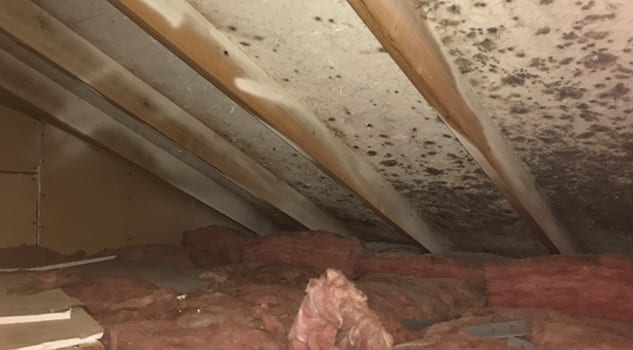
October is here in Indiana, and for many of us, that means it’s time to get in the attic and dig out the Halloween decorations. You may come across old family photos, an old suit you just can’t seem to part with, or something even more scary than the plastic ghouls and goblins you had been searching for: a mold problem.
In the Attic? How did that happen?
Attics, like crawlspaces, are another place in the home that is rarely visited. It’s another one of those out of sight, out of mind kind of places. They are sweltering hot in the summer and brutally cold in the winter. This temperature change is the main reason attics develop mold. But wait, mold needs moisture to grow, right? So what causes moisture in the attic?
Damp Basements and Crawlspaces May Lead to Moldy Attics
“Generation of humidity is significant through living. Breathing, sweating, cooking, bathing, cleaning, and numerous other activities pump water into the air.” Even having a lot of house plants can add a lot of humidity to the air in your home. Damp basements and crawlspaces often lead to a moldy attic. Moisture can also make its way to your attic through poorly sealed bypasses. These bypasses can include cable wires, plumbing vents, furnace vents, whole house attic fans, unused or misused dryer vents, and improperly installed bathroom exhaust fans. But mold grows in hot and humid temperatures, so how does mold affect my attic when it’s cold outside?
Warm Air Meets Cold Attic = Moisture
Remember in seventh-grade science class when we learned that heat rises. When the cold temperatures of fall and winter set in, homeowners begin to heat their homes. In homes where there is a lot of moisture in that warm air and it finds its way into a cold attic, the water in the air will create condensation on cold interior surfaces just like it would on a glass of iced tea on a hot summer day.
Depending on how cold it is outside, this condensation will actually freeze at night. Then, in the morning when the sun comes up, those tiny little icicles will melt and drip onto the floor. This cycle of moisture accumulation on dusty wooden surfaces of the attic is the perfect environment for mold growth. This could take decades, or only one season, and cause a minor surface mold, or a complete rot of roof sheathing…which means a new roof.
Hopefully we didn’t scare you out of your attics…if we did, it might be time to give us a call for a mold remediation consultation!!
